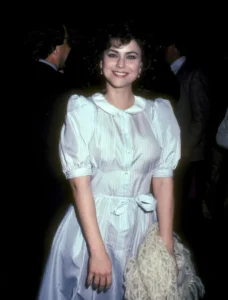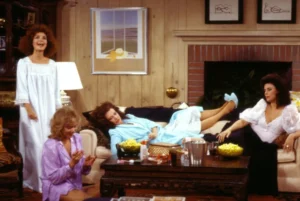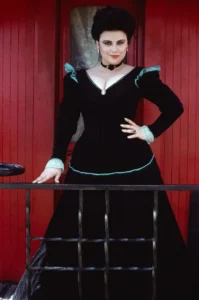This ’80s Star Faced Cruel Mockery for Her Weight – But Her Husband’s Loyalty for 35 Years Will Melt Your Heart
She was treated harshly and “tortured” by the media for gaining weight, leading to tough times and personal struggles. This is the story of an ’80s TV star’s rise to fame, her battles, and the love that helped her find hope.
In the late 1980s, this actress became widely known for her humor and big personality on one of TV’s most popular sitcoms. But with her fame came behind-the-scenes stress and public criticism about her weight.
Through all of this, her husband stood by her side with love and support, helping her rebuild her life far away from Hollywood’s spotlight.

In 1986, the actress got the role of Suzanne Sugarbaker on the hit sitcom Designing Women. Her humor and charm made her a fan favorite, and she seemed set for a long, successful career.
But the pressures of Hollywood started to affect her mental health. Behind the scenes, she struggled with depression, which had been an issue since she was a teenager. By the show’s second season, her condition got worse, and she would often isolate herself completely.
“Basically, I would shut down and hide,” she later said. “I didn’t want to leave the apartment until the dark feelings passed. It was very hard.”
Things got more serious during the fourth season, as panic attacks started to affect her work. These episodes were so frightening that her whole body would shake. Her close friend and co-star, Dixie Carter, would comfort her during these tough moments.

Despite her struggles, she continued with her role, but her weight gain became a focus of media attention. The tabloids gave her cruel nicknames like “Delta Bulk,” which deeply hurt her.
“The tabloids tortured me,” said her co-star, Annie Potts. The actress herself, a former beauty queen, was shocked by the media’s obsession with her body.
“I didn’t deserve this. Why are they so cruel?” she asked. She compared her experiences to those of stars like Elizabeth Taylor, who also faced unfair criticism for their weight.
As her struggles grew, she turned to food for comfort. “When I was depressed in L.A., it would be like, ‘Let’s just eat another Stouffer’s macaroni and cheese,’” she admitted.

Her weight gain wasn’t just about eating. It reflected her deeper emotional struggles. At one point, she reached 215 pounds, which caused tension with the show’s producers.
Feeling exhausted, she asked to leave the show. “I wanted out, but they wouldn’t let me,” she said. Eventually, a friend admitted her to the hospital, where she hit her lowest point.
“The nurse said I looked like a wounded animal,” she recalled. “I weighed 170 pounds and didn’t want to exist anymore.”

The actress didn’t want to hide anymore. She came up with an idea to address her weight gain in an episode of Designing Women.
“I didn’t want to make it easy for people to hurt me. I also wanted to show another side of Suzanne,” she explained.
The result was the powerful episode “They Shoot Fat Women, Don’t They,” where her character faced body image issues. The episode was a success, earning her a standing ovation and an Emmy nomination.
Still, tensions behind the scenes continued. In 1991, the actress was let go from the show, which was devastating for her. Feeling rejected by Hollywood, she left the spotlight and moved with her husband to New Orleans in 1995 for a fresh start.

In 1997, she faced another tough year. Her grandmother and a beloved pet passed away, and her mother battled breast cancer. Around this time, she was diagnosed with Type 2 diabetes.
“I knew I had to lose some weight,” she said. Slowly, she adopted a healthier lifestyle and managed to get back to 150 pounds—the weight she was when she met her husband.
Years later, the actress shared that she had once used crystal meth to lose weight. It started with diet pills during drama school in London. When she returned to the U.S., someone gave her the stronger substance.
“Nobody knew about crystal meth back then,” she said. She took it before work and wouldn’t eat for days. Thankfully, brighter days came after she met her husband.
A Love That Never Wavered
The actress’s life changed in 1987 when she met Gerald McRaney, an actor cast as her ex-husband in Designing Women.
Their on-screen chemistry turned into a real-life romance. McRaney made his feelings clear early. “He proposed on our second date,” she said, laughing.
McRaney added, “I wasn’t going to let her get away. I had competition, so I moved fast.”
They married in 1989, and from the start, McRaney was her biggest supporter. “The weight never mattered to him,” she said. “He always told me he didn’t care, though I found that hard to believe.”
For McRaney, their bond was about true love. “If you want a trophy wife, that’ll turn out empty. But if you want a real wife, you love the person—no matter what,” he said.
During one of her darkest moments, McRaney proved his love. After her dismissal from Designing Women and endless media attacks, she reached a breaking point. Alone in her car, she swallowed pills and called McRaney.
“I didn’t know where I was, but he found me,” she said.
When she was later diagnosed with diabetes, he supported her through the lifestyle changes.
“Mac loves me no matter what,” she said. “Even when I was as big as a house, he thought I looked great!”
Finding Peace and Joy
Over the years, their bond only grew stronger. In 2017, when McRaney won an Emmy, he honored her in his speech.
“At the end of a long day, I get to come home to her—that’s the fun,” he said.
Though the actress stepped back from the spotlight, she found happiness. “I love my life for the first time,” she shared. “And I love him desperately.”
Today, she still works in Hollywood, but at her own pace. In 2019, she appeared in Dolly Parton’s Heartstrings, showing her lasting talent.
Throughout her career, she also explored producing and acting in shows like Drop Dead Diva and Boston Legal.
Her journey from fame to struggles and then to peace is a story of resilience. Despite the hardships, her husband’s constant love and support were her greatest strength.
